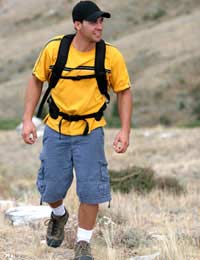Walking for Physical Rehabilitation

Walking is excellent exercise, a good way to get and stay fit and lose some weight. Walking also has its place in physical therapy and rehabilitation.
The need for walking as a physical therapy arises as a result of a physical injury/trauma or a stroke where the patient needs to regain balance and build or retrain leg muscles. This type of therapy will usually involve working inside with a therapist, using handrails or sticks, often learning to walk all over again. With someone who has to completely learn how to walk again, this can take a long time, often months.
Patients will graduate to walking slowly with a stick. This will eventually improve to the point where the patient will be able to walk without any aids; this is where walking for physical rehabilitation becomes important.
Finding A Regimen
For several years doctors have advocated exercise three times a week, with sessions lasting 30 to 60 minutes. For those in rehabilitation this might not be possible, but the goal for them is somewhat different.Having reached the stage where they can walk unaided, patients who have undergone physical therapy are ready for a little more of a challenge. This allows them to build more muscle tone and to increase stamina and endurance.
It has to be a gradual process, and needs to be planned with the doctor and physical therapist. The walks should graduate very slowly. Initially, at least, they should be on flat ground and of short duration. The idea is to slowly increase the distance and time spent walking. To begin, the patient might just cover one-quarter of a mile and that could be a big achievement. Over time that could become half a mile, then a full mile, but all still on a flat surface. This progress must not be hurried, but the increases should stretch the patient slightly without causing too much exertion.
Using Hiking
Hiking needs to be a supervised activity for those who are undergoing physical therapy and rehabilitation. Starting on something like a canal tow path, where there are often places to stop and rest, is a good first step, as it’s flat and not too taxing. But walking with someone at this stage remains vital.Depending on the speed and degree of the rehabilitation, it can be a long time before the patient is ready to tackle even gentle slopes and steep hills might always remain out of reach for many. It’s fine if progress is slow, but distances can increase as the rehabilitation continues. Hiking should still be supervised until the patient can comfortably complete a at least a one mile walk without breaks in a reasonable time.
By then muscle tone will be good and stamina will be greatly improved. From there the patient can continue walking, slowly building up the distance and degree of difficulty of the hikes. Before any large undertakings, always talk to the doctor, only do them as part of a group.
Walking is only part of a complete physical therapy programme. As the patient improves it’s one that can be easily carried out, and used as a vital tool for ongoing improvement.
- The Best Hiking Snacks
- Avoiding Leg Cramps When Walking
- How to Prepare for the Hiking Season
- Hiking for Older People
- Walking for Fitness: A Plan
- Fell Running: Is it for You?
- What is SwimHiking?
- Walking on Roads
- A Solo Walking Guide
- How To Avoid Blisters When Hiking
- General Health And Safety When Walking
- What to do in an Emergency
- Walking for Health
- Walking Injuries
- How to Prevent Walking Injuries
- How To Take Care Of Your Feet When Hiking
- Nutrition for Walking


Re: Walking on Roads
I have never attempted any form of hiking. This year i am 87, I’m pretty’s fit, I walk with dog between five and. Six miles every day, summer and…
Re: Starting a Walking Club
Hi I'm a naturist from North Wales and wanted to reach out to people that would like to join a clothing optional walk what's the best way…
Re: Starting a Walking Club
Do I need insurance for a walk/run group?. It’s a completely free group so no joining fee or charges. It’s run by volunteers. I don’t…
Re: Join A Walking Club
I need to hike...do something for my self...I love the outdoors and hiking...I need to meet new friends...who injoys the outdoors like…
Re: Starting a Walking Club
What sort of paperwork/ registration/ insurance might you need for walking group?
Re: Join A Walking Club
Hi, Any advice on liability/protecting yourself when setting up a walking club? What if someone hurts themselves? Thanks, Sam
Re: Starting a Walking Club
Hello, Do you know of any software that facilitates putting together walking/hiking clubs programme schedule? I am looking for…
Re: Join A Walking Club
I am looking to join a walking/hiking club in the Southampton/Hampshire area. I am 50 and have signed up for London to Brighton Challenge and…
Re: Join A Walking Club
Looking for a short walk partner n to make friends in tipton area of west midlands
Re: Join A Walking Club
Hi I am 33 and am looking to join a walking club for health and social reasons. I currently live in huntingdonshire.